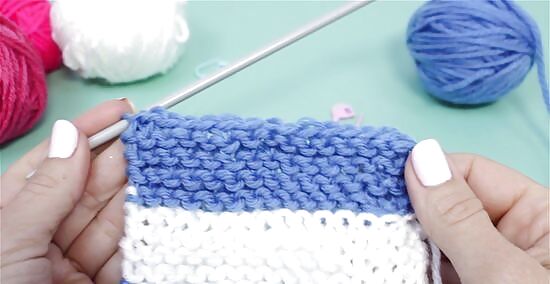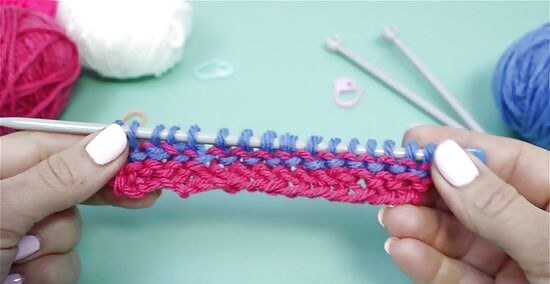
views
X
Research source
Changing Colors

Start knitting. Whether you're working from a pattern or just knitting freely, use your main color to knit as many stitches and rows as needed in your desired style of stitch. When you get to the point where you'll be changing colors, finish the last stitch on the row you're working on. New colors usually get added at the beginning of a new row. When you add a new color, don’t cut the yarn from the original color. Instead, just leave it hanging where you left off. When possible, join yarn of the same color in a spot where it won’t be as noticeable, such as at a seam or in a spot that’s tucked away, like under an arm on a sweater.

Insert the needle into the first stitch. Start the next row as you normally would, by sticking the tip of the right needle in the first stitch on the left side. Grab your contrasting color and give yourself a tail that’s at least six inches long (longer is fine). In knitting, the dominant color is called the main color, and additional colors are called contrasting colors.

Knit a couple stitches with your working yarn and tail. Take the working yarn and tail of the new color and wrap them both around the tip of the needle that’s inserted into the first stitch. Gently tighten the previous stitch to keep it from coming loose. Knit like this, using the tail and the working yarn, for about three stitches to help secure the new yarn in place.

Continue knitting normally. After the first three stitches, drop the tail and knit normally with the new color. If you are going to be knitting stripes or changing back and forth between the two colors, you can carry the yarn so that you don’t have multiple tails to deal with later.

Weave in the tails. When you have finished knitting your piece, cut the excess yarn off, leaving tails of about six inches that you can secure by weaving them into the knitting. Grab a tapestry needle and thread the needle with the yarn tail. Turn your work over so you're working on the wrong side, and then: Pick a yarn that you can follow with the tail. The idea is to weave the tail through your knitting, following the same piece of yarn, to hide it behind that yarn. Use the tapestry needle to weave through the stitches on the backside, following the same piece of yarn the whole way. Don’t pull the tail too tight: you want it to be the same tension as the rest of the knitting. Knit about six inches of tail to secure it properly. When you're finished, gently stretch the knitting out and then trim the end of the tail.
Carrying Yarn

Start knitting. If you are knitting stripes or other patterns that require you to switch colors every few rows, you can carry the other yarn with you up the side of your work so that you don’t end up with a bunch of loose tails at the end. If your knitting in pink with blue stripes, for instance, start your knitting with the pink yarn. The carrying yarn method really only works when you're knitting back and forth, not in the round.

Switch colors. When it comes time to change colors, switch to blue following the instructions above and knit your first row. When you get to the second row with your new color, it’s time to carry the pink yarn up.

Carry the yarn. Wrap the pink yarn over top of the blue yarn one time. Then, pick up the blue yarn from underneath the pink and make your first stitch. This yarn twist will lock the pink yarn into the first stitch on the new row, leaving it easily accessible. Continue knitting that row with the blue yarn. As you work, give your knitting a gentle tug to prevent the yarns from becoming to tight. If they are, they could bunch up and distort the knitting. Also make sure the yarn you're carrying isn’t too loose, as this will create large loops. As long as you're going to continue switching between the two colors, continue carrying the yarn for each new row, even when you change colors again.
Alternating Colors

Begin knitting. There are many intricate color patterns in knitting that require you to change the yarn color multiple times in a single row, such as fair isle patterns. To do this, you can use a technique called stranded knitting, where you float the yarn you aren't using horizontally behind the work so that you can alternate between colors when necessary. To start, knit as many stitches or rows as needed in your first color. When the pattern indicates to change colors, do so by joining the new yarn color as practiced above.

Hold the yarns properly. For stranded knitting, you will hold and carry both yarn colors at the same time. Hold your background (main) color normally in your right hand. Hold your contrast color in your left hand, continental style. Alternatively, you can hold your contrast color in your right hand, but be sure to wrap it around your ring and pinky finger. Continue knitting according to the pattern, alternating between the colors as needed. Be sure the keep the float loose, otherwise it will cause puckering. However, you don’t want it so loose that it’s drooping down and catching on things.

Catch the float. If your pattern requires you to go more than five stitches with one color, you will need to catch, or wrap, the floating yarn to ensure it doesn’t get too long. To catch a float from your contrast color, insert the needle as usual, but make sure it goes under the yarn on the left hand. Finish knitting the stitch with the background color in your right hand. To catch a float from your background color, insert the needle into the stitch and wrap the background color around the needle, but don’t knit the stitch. Instead, wrap the contrast color around the tip, then unwrap the background color and knit the stitch with the contrast color. Always follow a caught stitch with a regular one.

Twist the yarns at each new row. Once you’ve got both yarn colors going, make sure you twist the yarns around each other once at the beginning of every new row if you're knitting back and forth. This will ensure both yarns are available when you need them.

Finish your project. Gently stretch out the knitting to even out the stitches. When you have finished, weave the tails into your knitting to secure them in place.



















Comments
0 comment